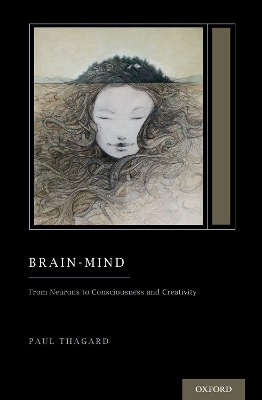
Brain-Mind
Oxford University Press Inc (Verlag)
978-0-19-761859-2 (ISBN)
How do brains make minds? Paul Thagard presents a unified, brain-based theory of cognition and emotion with applications to the most complex kinds of thinking, right up to consciousness and creativity. Neural mechanisms are used to explain mental operations for analogy, action, intention, language, and the self.
Brain-Mind develops a brilliant account of mental operations using promising new ideas from theoretical neuroscience. Single neurons cannot do much by themselves, but groups of neurons work together to accomplish powerful kinds of mental representation, including concepts, images, and rules.
Minds enable people to perceive, imagine, solve problems, understand, learn, speak, reason, create, and be emotional and conscious. Competing explanations of how the mind works have identified it as soul, computer, brain, dynamical system, or social construction. This book explains minds in terms of interacting mechanisms operating at multiple levels, including the social, mental, neural, and molecular. Unification comes from systematic application of Chris Eliasmith's powerful Semantic Pointer Architecture, a highly original synthesis of neural network and symbolic ideas about how the mind works.
This book belongs to a trio that includes Mind-Society: From Brains to Social Sciences and Professions and Natural Philosophy: From Social Brains to Knowledge, Reality, Morality, and Beauty. They can be read independently, but together they make up a Treatise on Mind and Society that provides a unified and comprehensive treatment of the cognitive sciences, social sciences, professions, and humanities.
Paul Thagard is a distinguished philosopher and cognitive scientist who has written many books, including The Brain and the Meaning of Life (Princeton University Press, 2010) and The Cognitive Science of Science (MIT Press, 2012). He is a Fellow of the Royal Society of Canada, the Cognitive Science Society, and the Association for Psychological Science.
Preface
Acknowledgments
1. What are Minds?
Why Minds Matter
What are Minds?
Cognitive Science
Representations and Processes
Mechanisms
Looking Ahead
Summary
Notes to Chapter 1: Minds
2. How Brains Make Minds
Why Brains Matter to Mind and Society
Thinking with Cells
Neurons
Neural Groups
Combining Neural Representations
Semantic Pointers
The Semantic Pointer Architecture
Innateness versus Learning
Summary and Discussion
Appendix: Details and Comparisons
Notes to Chapter 2: Brains
3. Perception and Imagery
Why Perception and Imagery Matter to Mind and Society
From Sensation to Perception to Imagery
External Senses
Internal Senses
Imagery
Mental Mechanisms for Imagery
Neural Mechanisms for Imagery
Uses of Imagery
Summary and Discussion
Notes to Chapter 3: Perception
4. Concepts
Why Concepts Matter to Mind and Society
Theories of Concepts
Neural Mechanisms for Concepts
Uses of Concepts
Summary and Discussion
Notes to Chapter 4: Concepts
5. Rules
Why Rules Matter to Mind and Society
Mental Mechanisms for Rules
Neural Mechanisms for Rules
Uses of Rules
Summary and Discussion
Notes to Chapter 5: Rules
6. Analogies
Why Analogies Matter to Mind and Society
Mental Mechanisms for Analogy
Neural Mechanisms for Analogy
Uses of Analogies
Summary and Discussion
Notes to Chapter 6: Analogies
7. Emotions
Why Emotions Matter to Mind and Society
Psychological Theories of Emotion
Neural Mechanisms for Emotions
Uses of Emotions
How Emotions Change
Summary and Discussion
Notes to Chapter 7: Emotions
8. Consciousness
Why Consciousness Matters to Mind and Society
Psychological Theories of Consciousness
Neural Mechanisms for Consciousness
Uses of Consciousness
Summary and Discussion
Notes to Chapter 8: Consciousness
9. Action and Intention
Why Actions Matter to Mind and Society
Psychological Theories of Action, Intention, and Will
Neural Mechanisms for Action and Intention
Uses of Action and Intention
The Will
Summary and Discussion
Notes to Chapter 9: Action
10. Language
Why Language Matters to Mind and Society
Syntax First: Chomsky
Integrating Syntax, Semantics, and Phonology
Meaning
Conceptual Blending
Metaphor
Innateness and Language Learning
Summary and Discussion
Notes to Chapter 10: Language
11. Creativity
Why Creativity Matters to Mind and Society
What is Creativity?
Images
Concepts
Rules
Procedural Creativity
Analogies and Metaphors
Emotions
Case Study: CRISPR/Cas9
Summary and Discussion
Notes to Chapter 11: Creativity
12. The Self
Why the Self Matters to Mind and Society
What is the Self?
Semantic Pointers for Self-Representation
Semantic Pointer Mechanisms for Self-Effecting and Self-Changing
Multilevel Systems
Molecular Mechanisms
Social Mechanisms
Summary and Discussion
Notes to Chapter 12: Self
References
Index
| Erscheinungsdatum | 11.08.2021 |
|---|---|
| Reihe/Serie | Oxford Series on Cognitive Models and Architectures |
| Verlagsort | New York |
| Sprache | englisch |
| Maße | 155 x 231 mm |
| Gewicht | 499 g |
| Themenwelt | Geisteswissenschaften ► Philosophie |
| Geisteswissenschaften ► Psychologie ► Allgemeine Psychologie | |
| Geisteswissenschaften ► Psychologie ► Verhaltenstherapie | |
| ISBN-10 | 0-19-761859-6 / 0197618596 |
| ISBN-13 | 978-0-19-761859-2 / 9780197618592 |
| Zustand | Neuware |
| Informationen gemäß Produktsicherheitsverordnung (GPSR) | |
| Haben Sie eine Frage zum Produkt? |
aus dem Bereich


